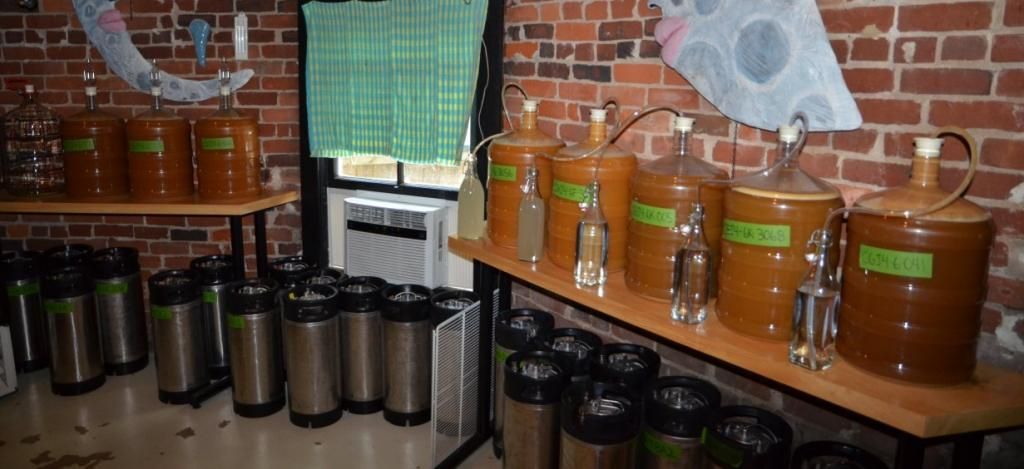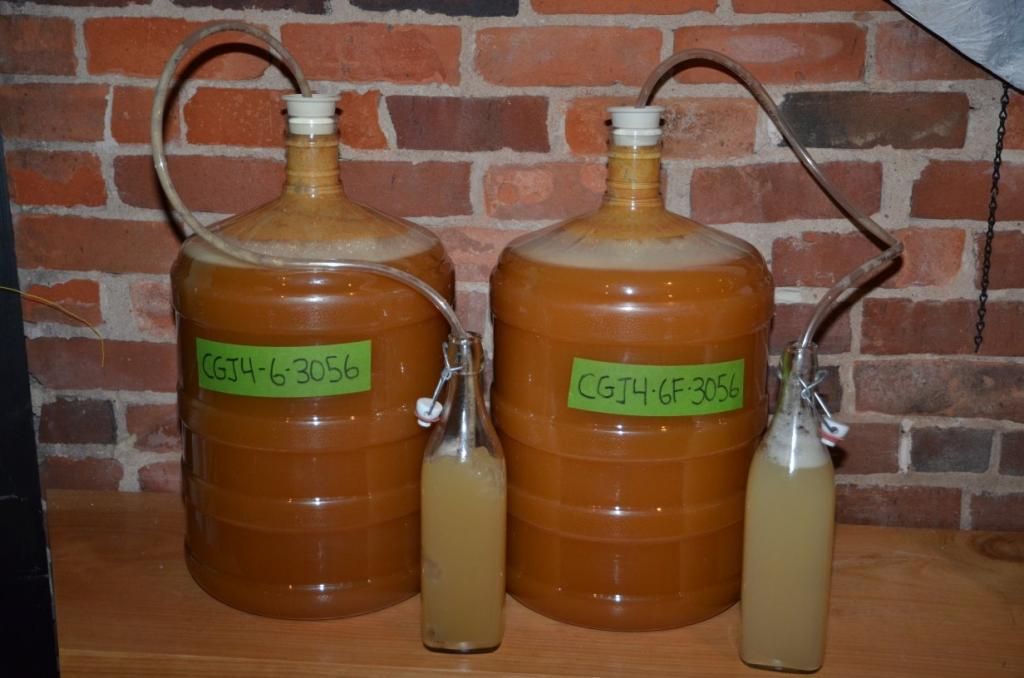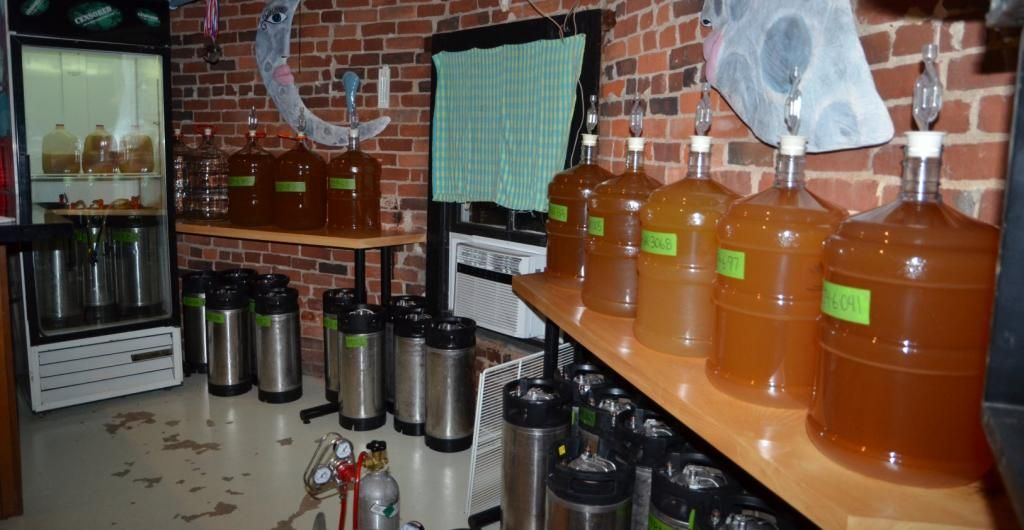Over the years, I’ve learned a lot more about apples and juice mixes, so I figured it would be helpful to pull together some of this info into one post. Here goes:
Juice Blends:
Most cider making books describe juice blending using traditional cider apple blends (sweets, sharps, bittersharps, bittersweets, etc). If you have your own orchard, this is a great way to go. For everyone else, its nearly impossible to find traditional cider apples on the commercial market. Fortunately, you can make a pretty good juice mix from blends of commercially grown apples.
Keep in mind that the majority of the juice on supermarket shelves and even a lot of the juice that you’ll find at farmers markets and orchard stands is usually red and/or golden delicious apples – those varieties bear heavily and have high juice yields. Sometimes they will be mixed with a sour apple variety to provide a tart finish. The juice may taste OK when fresh, but when you ferment most of the sugar off, there isn’t a lot of flavor left.
To put it in beer terms – most of the juice on the market is the equivalent of using a cheap dry malt & dextrose kit. You may be able to get drinkable results, but if you have any sort of skill, you will do a lot better with fresh wort and hops. The great thing about cider, is that to have top quality ingredients, you don’t need to spend half a day mashing grain - but you may need to invest a little time up front to find a really good source of juice. Once you have a good juice source, it’s the equivalent of being able to drive up to your favorite brewery and fill up your carboys with their fresh wort.
When you are evaluating a juice mix for fermenting, you want to pay attention to at least four dimensions. First the smell – if it doesn’t smell good before the ferment, its not likely to get better. Then the first hit of the taste, which should be appley and sweet. The initial sugar taste should fade out fairly quickly and not be syrupy. The midrange is harder to describe, but want a nice flavor when its sitting in your mouth – preferably multiple flavors.- something that remind you of biting into an apple in an orchard. Then you have the finish, where a tart note is nice as long as not too tart. If you are making a dry cider, than you will want to have some tannin present also. Ideally the overall flavor profile will be almost too intense for drinking as table juice, except maybe for sipping.
With most commercial apples you will be really lucky to get 2 or 3 of the 4 basic dimensions, which is where the blending comes in. Blending apples is fairly subjective process and I don’t claim to have any great skill at this - so consider this a starting point for your own experimentation. Also some folks like to ferment each variety separately and then blend after fermentation. I prefer to do the blending first, because that way I know roughly what I’m getting. But to each his/her own here.
I tend to categorize commercial cider apples into three types: Base apples, which provide a lot of the sugar and body. Flavor/Aroma apples, which provide added flavor and aroma, but generally cant carry a mix on their own, and finish apples, which provide a lot of the acidity that you taste in the finish. Often there is a good bit of overlap here, as quite a few apple varieties can be used for multiple purposes. Here are a few that I’ve used over the years. There are certainly a lot more varieties that are available - these are just the ones that I have experience with. Personally, I like to mix at least one apple from each category when making a blend. It certainly doesn’t hurt to have more:
“Base” apples
Stayman – Traditional cider apple, could hold its own as a single varietal if necessary
Turley Winesap – Very similar to Stayman
Cameo – Also similar to Stayman
Pink Lady – Good late season base apple
Northern Spy – Hard to find this far South, but a great base for Northern Climes
Spitzenburg – Traditional cider apple, Good sugar content, has a pear like sweetness.
Ashmead’s Kernel – Traditional cider apple, Good sugar and flavor, hold its own as a single varietal if necessary
Grimes Golden – Good early season base apple
Cortland – Good for early season mix
Honey Crisp – A bit one dimensional, but OK for early season base apple.
Prima – Another good early season base apple, but tends not to clear well
Golden Delicious – Will work in a pinch if you have good flavor and tart apples to mix
“Flavor/Aroma” apples
Gala – Has a great aroma, but doesn’t keep well, so mostly for early season mixes
Summer Rambo – Another good early season flavor apple.
Rome – Great flavor, but tends not to clear very well
Albemarle Pippen – Traditional cider apple, later season, can work as single varietal.
Empire – Decent midrange flavor
MacIntosh – Decent midrange flavor
Gold Rush – Sometimes can work as a single varietal, depending on orchard
Fuji – Makes a decent flavor apple
Arkansas Black – Good if you are doing a dry cider and want some tannin.
Black Twig - Good if you are doing a dry cider and want some tannin
Hewes Crab – traditional cider apple, good tannin, could hold its own as a single varietal, hard to find.
“Finish” apples
Jonathan – Good early season apple for adding tartness to the mix
Winesap – traditional cider apple, Great later season tart apple. Can often work as a single varietal.
York – nice flavor and tartness. Fresh juice sometimes tastes a little gritty, but that comes out during the fermentation
Granny Smith – good for a tart finish, but doesn’t contribute much else flavor wise.
Complicating this a bit is that the same type of apples can vary in sugar and aroma between two orchards depending on when they are picked, how much rain the trees got, etc. So its still best if you can taste what you are getting before pressing. If you are putting a blend together, usually the best thing you can do is get samples of all these apples, cut them into thin slices, stack the slices together and chomp away to see how they mix together.
If you are not going to press the apples yourself and are not buying enough quantity to spec your mix, then the next best option is to get to know whoever is running the press at your local orchard. Probably the main thing to look for if you are dealing with a commercial press is a press operator who either makes or likes hard cider and is keeping an eye out for good hard cider apples. One of the challenges of getting a good mix is that the apples ripen at different times, and depending on the market, not everything may be available as #2 cider grade apples, so you want someone who can be creative with what’s available. If you are buying juice from a farmers market or orchard, ask what apples are in the juice. It doesn’t hurt to mention that you are planning to make hard cider with the juice. If the person doesn’t know (or doesn’t want to tell you), chances are that its mostly red and golden delicious and wont amount to much, but sometimes you can get lucky.
Pasteurization
Most cider is either flash pasteurized or UV pasteurized, in which case its really hard to tell the difference in taste before and after pasteurization. The main difference that I’ve noticed is that unpasteurized juice will clear a little faster, as pasteurization tends to set the pectin in the juice. For that reason, I prefer unpasteurized juice. Pasteurizing also kills most of the wild microbes, so you don’t need to add sulfites to get rid of them prior to pitching your yeast (assuming that is something that you want to).
Sulfites
Sulfites are a double edged sword. On the one hand, the cider will generally last longer if you add sulfites. On the other hand, you pay a price in flavor in the short term, and most non-wine yeasts tend to stink a lot more during the fermentation when sulfites are present.
If you are planning on drinking your cider within a few months, and the apples are picked and processed in a relatively sanitary environment, I’d recommend skipping the sulfite.
If you want your cider to last more than a few months, then adding sulfite may be worthwhile. Just keep in mind that you will pay a short term penalty in the taste – a bitter bite that takes many months to mellow. Some palettes are more sensitive than others. I can usually tell the difference for a couple of months after fermentation. My girlfriend can tell the difference for up to 6 months, depending on how much I use.
One thing to keep in mind is that the “recommended” dose of k-meta (1/4tsp in 5 gal or 1 tablet per gal) is based on being able to create a certain amount of free SO2 when the k-meta is added to grape juice. However grape juice is very different than apple juice. Much more sugar and different acids. While you are not supposed to be able to taste the “recommended” dose of k-meta in grape juice, you can definitely taste it in apple juice.
For many years, I skipped the sulfite completely. For the first several months, they would always taste great, but out of 40 batches, I would typically lose 2-4 to vinegar by the time that summer rolled around. For the past couple years, I’ve been adding sulfites to about half of my ciders. The ones that I am planning to drink within the first six months don’t get any sulfite. For the ones that I’m planning to make last until next season, I’ll add between 1/6 and 1/8 tsp of sulfite to the juice, 24hrs before pitching. If the juice is nice and tart (ie high acid content), I’ll just use 1/8tsp. If the juice is not so tart, I’ll use 1/6tsp. That’s been working fairly well for keeping the ciders good year round.
On a few of the batches that I sulfited last year, and still haven’t drank yet, I’m starting to notice just a bit of an acidic twang starting to develop. More of an extra malic acid taste rather than a acedic acid (vinegar) taste, but still messes with the balance. This year, I’m planning to add an additional 1/8 tsp of sulfite at the end of fermentation for batches that I’m planning to store to get me through next year. I may also do some experiments with pasteurizing before pitching the yeast and using 1/8 tsp of sulfite afterwards – in order to reduce the overall amount of sulfite used
Sorbate
Stay away from juice that has sorbate added as a preservative. Its not even worth drinking as table juice. Yes, you can get it to ferment if you throw enough yeast at it, but it will taste like ass. I’ve done this myself a few times when I ran out of cider during the summer. Its nasty. Every month or so, someone posts that they accidentally bought juice with sorbate, and there is always someone who will attest that if you make the starter from hell then it can be fermented, but so what? You can ferment Mtn Dew, but it wont taste good. If you accidentally buy juice that has sorbate in it, save yourself the trouble and use it for animal feed.
Nutrient
I would recommend skipping nutrient if you are trying to get a sweet or semi sweet cider. In fact, for cold crashing to work reliably, you need to start with low nutrient juice – preferably from older standard trees that haven’t been fertilized. I have been fortunate to be able to get juice from an organic orchard, and that juice is very easy to work with. However, I’ve noticed that when they get #2 apples from other farms, the juice is not always so easy to work with and sometimes requires multiple crashing. Last year, they got a bunch of heirloom cider apple varieties from an old orchard that is being restored (and which got a lot of fertilizer last year). That juice tasted great, but it fermented like crazy and left me with a bunch of good tasting but very dry cider.
Adding nutrient is often suggested as a solution to getting rid of ‘rino farts’ ie sulfur production from stressed yeast. Nutrient will often help with this, but at the expense of an accelerated fermentation. If you are looking to make a sweet or semi sweet cider, then a better solution is to move the carboy to a cooler location, so that the yeast aren’t trying to digest the sugars quite so fast.
Jim Koan, who is the cider maker at JK Scrumpy, did a
podcast a while back in which he discussed the lengths that they go to in order to reduce the nitrogen in their apples. Andrew Lea also has a bit to say on this in
Nitrogen - the Forgotten Element in Cider Making
Finding Juice
The
Orange Pippen website is a pretty good resource for finding orchards in each state. Farmer's markets, roadside stands, etc can be a good source as well. If you can, find a source that can tell you the apple mix and recommend whats good for hard cider given whatever is available locally.
Good Luck!










![Craft A Brew - Safale S-04 Dry Yeast - Fermentis - English Ale Dry Yeast - For English and American Ales and Hard Apple Ciders - Ingredients for Home Brewing - Beer Making Supplies - [1 Pack]](https://m.media-amazon.com/images/I/41fVGNh6JfL._SL500_.jpg)


















































